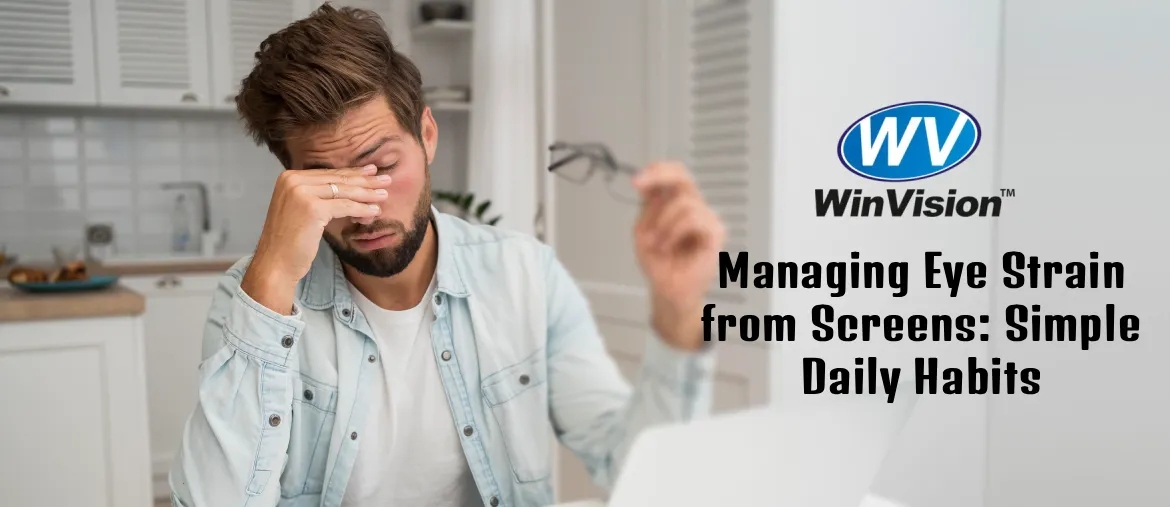In the digital age, our eyes are always on screens, whether it’s a smartphone, laptop, tablet, or TV. These gadgets certainly make life easier, but they also present a challenge to our eye health. Extended periods of looking at a screen can cause your eyes to become dry or tired. This condition is commonly referred to as digital eye strain. It can be dry, irritated, and blurry, and cause headaches and neck and shoulder pain.
The good news? Like any strain, eye strain can be relieved.
Understanding Digital Eye Strain
Eye strain is a symptom rather than a disease itself and is caused by overuse of the muscles that control focusing. Eyes blink less when using digital devices; their usual rate is 15 to 20 times per minute, but when they use devices, people tend to blink only five to seven times per minute. This decreased blinking leads to dry and irritated eyes.
Eventually, these can cause symptoms like:
- Burning or itchy eyes
- Blurred or double vision
- Headaches
- Neck and shoulder pain
- Difficulty focusing
Follow the 20-20-20 Rule
After every 20 minutes of screen time, look away for 20 seconds at something more than 20 feet away. This lets the eye muscles relax and refocus, which helps prevent eye fatigue. Set reminders or use apps that notify you to take breaks at certain intervals.
Blink Often and Use Lubricating Eye Drops
Try to make a conscious effort to blink as much as you can when you’re staring at a screen. If your eyes are still dry, speak with your ophthalmologist about which brands of preservative-free lubricating eye drops they recommend. They are like natural tears and keep your eyes moist all day.
Adjust Your Screen Settings
Here’s how to set up your display:
- Brightness: Match your screen brightness to the ambient light.
- Contrast: Increase the contrast a little to make the text more readable.
- Font size: Change the size of the text so that you do not have to squint or lean towards the screen.
- Color temperature: Apply warmer colors, especially at night, to minimize exposure to the blue light.
Ensure Proper Lighting
Avoid glare on your monitor from sunshine and fluorescent lights by keeping your screen out of the path of those light sources. Use dimmable lamps with a shade. The objective is to establish a comfortable level of contrast between the brightness of your screen and that of the ambient light.
Maintain the Right Screen Distance and Posture
The distance between the screen and your eyes should be about 20-24 inches (or an arm’s length), with the top of the screen positioned slightly below your eye level. This allows your neck and shoulders to rest in a relaxed position. Never slouch or lean forward; this will only contribute to physical discomfort and fatigue in your eyes.
Take Frequent Breaks from Screens
Besides the 20-20-20 rule, think about scheduling longer breaks during the day. Get up from your desk to stretch, or just shut your eyes for a moment. Movement stimulates blood flow, and improved blood flow is good for your body and your eyes.
Stay Hydrated and Eat Eye-Friendly Foods
Tightness and irritation are heightened when you’re dehydrated. You should drink more water during the day to keep your body (and your eyes) hydrated, and eat more omega-3 fatty acids, vitamin A, vitamin C, and lutein-rich foods. Eating well for your eyes, foods such as carrots, spinach, fish, eggs, and citrus fruits, promote good long-term eye health.
Schedule Regular Eye Check-up
Regular eye check-ups are necessary even if you have no sight problems. Early strain, dry eye, or refractive errors that may be worsened by screen use can be detected by an ophthalmologist. It is claimed that the lenses improve visual comfort by blocking part of the damaging blue light.
Screen-related eye strain is one of the most common modern health complaints, and the easiest remedy. A few simple, regular practices, including taking the 20-20-20 break, having adequate lighting, and drinking enough water, will help prevent this pain and maintain the healthiest eyes. We all live in a digital age, so it’s important to take care of your eyes. Make them your priority every day, because when your vision is clear and comfortable, everything else becomes easier to see.

